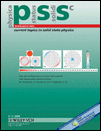Electrical transport in strained La0.7Ca0.3MnO3 films
Abstract
Magnetotransport properties of La0.7Ca0.3MnO3 thin films deposited on (100) LaAlO3 substrate were investigated. Fine balance between the charge ordered insulating phase and ferromagnetic metallic phase results in a number of glassy features such as: significant hysteresis, memory effects and long-time resistivity relaxation at turning on and off of magnetic field. It was found that in the temperature range 10–220 K the resistance of thin film decreases significantly upon applying electric current and this effect cannot be explained by homogeneous Joule heating. The magnetotransport properties of the thin films are discussed in the frame of cross-coupling of charge, spin and strain. (© 2006 WILEY-VCH Verlag GmbH & Co. KGaA, Weinheim)




